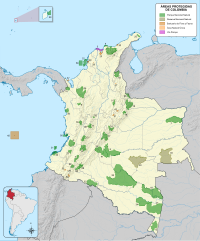Cueva de los Guácharos
Cueva de los Guácharos National Natural Park (English: Cave of the Oilbirds)[1] is the oldest national park in Colombia. Located in the western face of the Colombian Eastern Andean Range in the departments of Huila and Caquetá, the park covers an area of 9,000 hectares (90 km2; 35 sq mi).[2][3] The caves formed from the karstic zones of the Magdalena and Caquetá rivers.[4][5]
The park is intended to protect the cloud forest and páramo ecosystems. This area hosts one of the last intact oak forests in the country, with the native oak species Quercus humboldtii (Bonpl.) and Trigonobalanus excelsa (Lozano, 1979)).
Biodiversity
In 2005, the National Natural Parks System identified 296 registered species of birds in the park.[6] Further recorded species are:
| Species | Family | Common name | Range | Conservation status |
|---|---|---|---|---|
| Lagothrix lagotricha lugens (Humboldt) | Cebidae/Atelinae | Churuco monkey | High Amazon valley | |
| Cebus apella (Linnaeus) | Cebidae/Cebinae | corn monkey | Andes\Amazonas | |
| Ateles paniscus (Linnaeus) | Cebidae/Atelinae | marimonda | mid and low Amazon valley | |
| Mazama americana (Erxleben) | Cervidae/Odocoileinae | páramo deer | Neotropic | |
| Mazama rufina (Lesson) | Cervidae/Odocoileinae | páramo deer | ||
| Pudu mephistophiles (De Winton) | Cervidae/Odocoileinae | rabbit deer | North Andean: northern Ecuador to southern Colombia | |
| Tapirus pinchaque (Roulin) | Tapiridae | páramo tapir | threatened |
References
- ^ Hilty, Steven L.; Brown, Bill (1986). A Guide to the Birds of Colombia. Princeton University Press. p. 34. ISBN 978-0-691-08372-8.
- ^ Bonell, Francisco (12 October 2011). "El Parque Nacional Cueva de Los Guácharos cumplió 50 años" [The Cueva de los Guácharos National Park turned 50]. El Tiempo (in Spanish). Casa Editorial El Tiempo S. A.
- ^ "Descripción del Área" [Description of Area] (in Spanish). Parques Nacionales Naturales de Colombia. Archived from the original on 12 October 2014. Retrieved 24 December 2014.
- ^ Grzimek, Bernhard (1979). Animal Live, Volume 10: Mammals (in German). ISBN 978-3-423-03206-3.
- ^ Granados, Marta (1984). Colombia, Parques Nacionales [Colombia, National Parks] (in Spanish). Fondo para la Protección del Medio Ambiente Jose Celestino Mutis.
- ^ "Plan de Manejo Parque Nacional Natural Cueva Los Guacharos" [Management Plan: National Natural Park Cueva Los Guacharos] (PDF) (in Spanish). National Natural Parks System. 2005. p. 56. Archived from the original (PDF) on 2014-12-25. Retrieved 2014-12-25.
- v
- t
- e
- Alto Fragua Indi-Wasi
- Amacayacu
- Bahía Portete
- Cahuinarí
- Catatumbo Barí
- Chingaza
- Corales de Profundidad
- Corales del Rosario y San Bernardo
- Cordillera de los Picachos
- Cueva de los Guácharos
- Doña Juana-Cascabel Volcanic Complex
- El Tuparro
- Farallones de Cali
- Isla Gorgona
- La Paya
- Las Hermosas
- Las Orquídeas
- Los Katíos
- Los Nevados
- Macuira
- Munchique
- Nevado del Huila
- Old Providence McBean Lagoon
- Paramillo
- Pisba
- Puracé
- Río Puré
- Sanquianga
- Selva de Florencia
- Serranía de Chiribiquete
- Serranía de la Macarena
- Serranía de Los Churumbelos Auka-Wasi
- Serranía de los Yariguíes
- Sierra Nevada de Santa Marta
- Sierra Nevada del Cocuy
- Sumapaz
- Tamá
- Tatamá
- Tayrona
- Tinigua
- Uramba Bahía Málaga
- Utría
- Yaigojé Apaporis

- Ciénaga Grande de Santa Marta
- El Corchal "El mono Hernández"
- Galeras
- Guanentá Alto Río Fonce
- Iguaque
- Isla de La Corota
- Los Colorados
- Los Flamencos
- Malpelo
- Otún Quimbaya
- Plantas Medicinales Orito Ingi-Ande
- Playona Acandí
- Nukak
- Puinawai








































